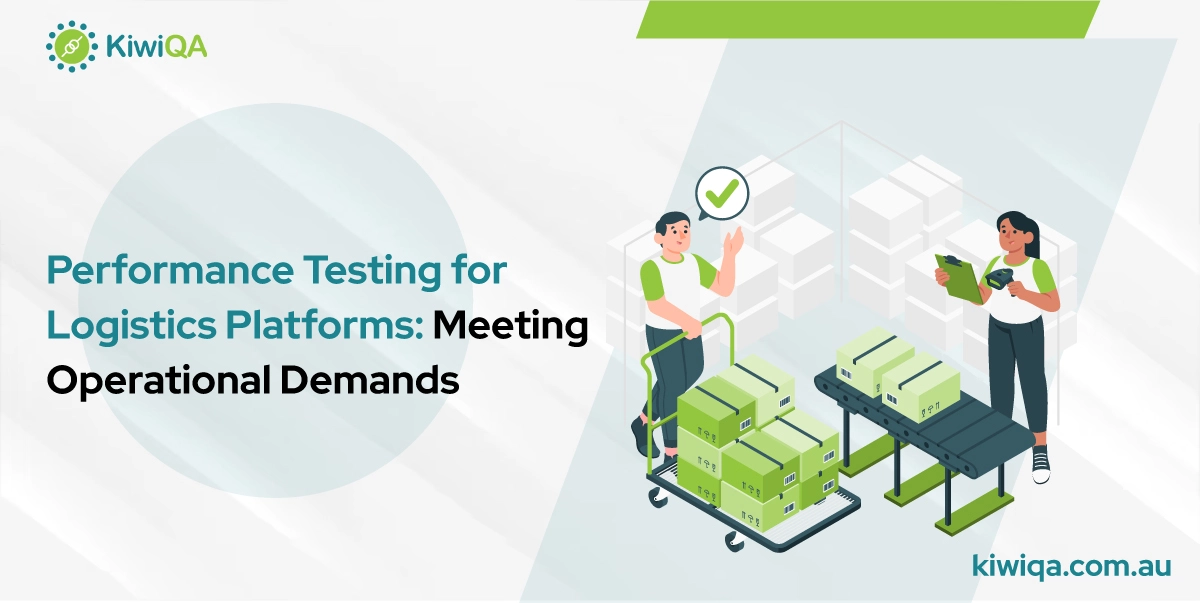Performance Testing for Logistics Platforms: Meeting Operational Demands

As the online industry is rising frequently, a smooth logistic workflow is necessary. In the current era, consumer expectations are high, so the reliability of the logistic service can either make or break your brand reputation. As per the reports, the digital market is designed to cross $50 billion by 2025. Ensuring the effectiveness of the supply chain is crucial. Performance testing solutions play a strong role in the corporate landscape.
Performance Testing for Supply Chain Platforms is a strategic method that directly relates to the scalability, speed & stability of logistic operations. By careful planning & executing performance tests, organizations can detect potential errors, optimize resource utilization & verify scalability. Now, technology has become paramount thanks to AI & ML. Failure to peak operational hours can cause disaster & cause lost sales & trust. Read the following blog to know a brief about how performance testing meets operational demands.
Performance Optimization for Logistics Systems is essential in today’s digitally connected society, where software programs serve as the foundation for many companies. Maintaining client trust, defending your reputation, and preserving your bottom line all depend on your application’s ability to withstand real-world situations. By confirming the system’s capacity to manage large amounts of requests and data, locating bottlenecks, and guaranteeing scalability and stability throughout peak loads, performance testing for logistics platforms guarantees seamless, effective operations.
By identifying sections of the platform that are generating delays or inefficiencies, performance testing enables engineers to optimize those areas and raise overall performance.
Consumers anticipate dependable and prompt payment processing and delivery notifications. Performance testing guarantees that the platform can fulfill these requirements, resulting in a satisfying user experience.
An effective online order system minimizes mistakes and maximizes operational efficiency by syncing orders, inventories, suppliers, and customer data on a single platform. Orders from several sales channels are easily collected and tracked by this single location, which is frequently called Order Management Software (OMS).
It offers a thorough view of order data, routes, inventory, warehouse connectivity, and financial activities. The OMS completes the sales funnel by integrating with CRM and inventory systems, providing marketing and accounting departments with useful data.
Choosing the best mode of transportation, air, sea, rail, or road, to maximize delivery time and save expenses is a key component of effective transportation management. In order to optimize load capacity and reduce empty miles also entails route planning and shipment consolidation.
This component includes tracking shipments and giving customers real-time information. Transportation management systems have advanced in sophistication due to technological improvements, providing solutions for transportation audit, payment, and route optimization in addition to reporting capabilities.
The warehouse staff can pull things for shipping as fast and effectively as possible if you have a good inventory management system that lets you see all of this information in real-time. Additionally, businesses may forecast customer demand for specific items by using sales data and other insights to enhance inventory management.
The Analytics and Reporting Module gives managers the ability to make well-informed choices and increase productivity by utilizing digital data to provide actionable insights. Business intelligence helps the organization go forward by identifying inefficiencies. With the help of integrated tools and APIs, logistics platforms with delivery tracking capabilities enable companies to monitor shipments in real time, improve customer communication, and boost operational efficiency.
Also Read : Best Practices for Performance Testing in Web Applications
Setting up complicated test settings, producing realistic data at scale, and deciphering findings to find underlying reasons are some of the difficulties that come with performance-testing solutions with large amounts of real-time data. Logistics systems deal with large numbers of transactions and data processing, particularly during busy times of the year or during events. Performance testing ensures smooth operations by confirming that the systems can sustain these surges without breaking down.
Systems encounter performance issues such as sluggish load times, shuts down, and instability during periods of high demand. Tactics like load testing, optimization, and resource allocations are a few options to verify and streamline operations. A system’s resource consumption rises with the number of users, which causes bottlenecks in page loading or app responsiveness.
The physical distance between users and servers causes interruptions in data transmission, which can affect both application efficiency and user experience. This makes geographic distribution and latency particularly problematic for applications that need real-time or low-latency communication.
Performance testing reduces the possibility of system outages, which may be expensive and disruptive in the logistics sector, by spotting and fixing performance problems early. Application speed and dependability may be impacted by performance issues, including latency, rate restriction, and reliance on other services that arise when third-party APIs are integrated. To guarantee a seamless user experience, addressing these calls for meticulous planning, thorough testing, and monitoring.
By locating and fixing possible bottlenecks and problems before they affect the supply chain, performance testing is essential in logistics to guarantee continuous deliveries and promote quicker, more dependable, and more effective operations.
To guarantee system responsiveness under load, verify scalability, locate bottlenecks, and optimize resource allocation, all of which enhance dependability and user experience, performance testing is essential in logistics.
By spending money on Performance Optimization for Logistics Systems, you can make sure that your application is dependable, quick, and able to manage high traffic volumes, which will maximize profitability and avoid revenue loss.
Customers are more inclined to trust a company and stick around when they can track shipments, make purchases, and operate a logistics platform with ease and without any problems.
Load Testing for Logistics Platforms determines how well a system performs under different load conditions, often known as the number of concurrent users conducting transactions. When the number of users or actions on a particular piece of software increases, load testing services
mainly keep an eye on reaction time and system stability. Teams should conduct several load testing scenarios in development, canary, QA, pre-production, and production environments to ensure testing is dependable. In order to avoid mistakes while releasing a new feature
One common kind of load testing is Stress Testing for Logistics Solutions, which evaluates the system’s performance under very high workloads. Stress tests confirm the system’s dependability and stability during higher-than-normal usage. Process time frames, paydays, peak times at the end of the workweek, and many other events can result in higher-than-normal workloads on systems, which could lead to regular higher-than-average traffic.
In order to understand how the system reacts under duress, stress testing frequently simulates an abrupt, heavy flow of user requests. In order to simulate situations like heavy traffic, processing big amounts of data, or prolonged operation, stress testing entails exposing a system to loads or circumstances that are noticeably higher than what it is intended to withstand.
Scalability Testing for Logistics Software assesses if the program is managing growing loads steadily. It is also feasible to experiment with other variables, such as memory, bandwidth, etc., while maintaining a constant load. This kind of non-functional testing looks at how a system reacts to load variations rather than simply a certain load level. In order to ensure that a system can manage higher user loads, data volumes, or transactions without experiencing performance degradation, scalability testing assesses the system’s capacity to scale up or down in reaction to changing demands.
One kind of stress testing called “spike testing” assesses how well software performs when workloads are rapidly and often increased. For brief periods, the workload exceeds typical expectations. The aim is to find out how a system responds to these erratic circumstances, including its capacity to scale, recover, and sustain performance both during and after a spike.
Potential bottlenecks, malfunctions, and performance problems that might not be noticeable under typical load circumstances might be found with the use of spike testing. Spike testing is frequently done using tools like Gatling and Apache JMeter, which let testers simulate load spikes and examine system reactions.
Endurance testing, also referred to as soak testing, assesses how well the program functions over a lengthy period of time under typical workload conditions. The aim of endurance testing is to check for system issues like memory leaks. When a system does not release discarded memory, a memory leak happens. The system may malfunction or perform worse as a result of the memory leak.
Maintaining performance levels over time impacts memory usage and resources, and long-term implications on application reaction times are crucial criteria examined during endurance testing. Services that are supposed to run around the clock depend on applications remaining stable and performing properly over extended periods of continuous operation, which is ensured by endurance testing.
An effective free-to-use tool for web applications is Apache JMeter. Because of its wide range of protocol support, it may be used in a variety of performance testing situations. JMeter’s broad plugin ecosystem and user-friendly graphical user interface make it an appealing option for performance engineers. Its wide interoperability with Java-based applications is a result of its Java architecture.
A thorough performance testing tool, Apache JMeter assesses web apps, including both static and dynamic resources. In order to evaluate the resilience and examine overall performance under different load scenarios, high-load situations may be successfully simulated on servers, networks, objects, or clusters of servers.
Features of this tool-
❖ JMeter is a flexible tool for a range of performance testing since it supports numerous protocols.
❖ By creating load on numerous computers, JMeter’s distributed testing feature allows it to manage a huge number of users.
❖ It offers comprehensive, editable reports that aid in the analysis of performance indicators and the detection of bottlenecks.
❖ JMeter is a cost-effective, use-free performance testing tool.
❖ JMeter’s vast plugin choices and broad range of supported protocols make it extremely versatile for a variety of testing needs.
Micro Focus created the industry-standard performance testing tool LoadRunner. This performance testing tool simulates virtual users interacting with software to identify possible performance bottlenecks and is used by businesses to evaluate the scalability, reliability, and speed of their applications. This tool for performance testing services supports several different protocols and is perfect for large-scale corporate applications.
Emulation of actual user behavior is made possible via LoadRunner, which enables the development of scripts that mimic human activities. Jenkins and other well-known CI technologies are integrated to create a more efficient DevOps workflow. In order to retrieve more detailed performance information, it offers connectivity with programs like AppDynamics and Dynatrace. It guarantees scalability, lowers infrastructure costs, and allows testing in cloud settings.
Features of this tool-
❖ HTTP, HTTPS, SOAP, and WebSockets are among the more than 50 protocols that LoadRunner supports.
❖ Comprehensive performance analysis is made possible by the tool’s broad analytics & insight reports.
❖ LoadRunner facilitates continuous performance testing by easily integrating CI/CD processes.
❖ By controlling dynamic data and user input, these features aid in simulating genuine user behavior.
❖ Effective insights into performance limitations are offered by smooth reporting.
Gatling is a performance-testing open-source tool for web services that is written in Scala. It lets you spot problems early on for a better time to market and helps you predict crashes and delayed response times. It assists developers and testers in gauging the effectiveness of their apps and making sure they run smoothly, even under extreme demand. By generating virtual users, it successfully mimics user behavior.
This tool for load testing services and solutions enables programmers to assess an application’s reliability, performance, and scalability under various load scenarios. Jenkins, Bamboo, TeamCity, and other well-known continuous integration systems are all easily integrated with Gatling. Additionally, sophisticated real-time reporting and insights are made possible by its connection with Grafana and other monitoring tools. Cloud-based performance testing is made possible by Gatling’s support for popular cloud platforms.
Features of this tool-
❖ Gatling can manage several concurrent users with less resource use thanks to its high-performance asynchronous engine.
❖ To assist in locating performance bottlenecks, it creates comprehensive and perceptive reports that include interactive HTML charts.
❖ It allows for automated performance testing by integrating easily with pipelines for CI/CD.
❖ High scalability is made possible via Gatling’s asynchronous design, which guarantees effective use of system resources.
❖ Teams can swiftly detect and resolve problems thanks to the thorough reporting options, which offer insightful information about application performance.
BlazeMeter is a tool for performance testing that runs in the cloud. Simulating a large number of virtual users enables users to do scalable and on-demand performance testing for mobile and web apps in order to evaluate their performance under various scenarios. To maximize application performance, BlazeMeter offers extensive testing, reporting, and analysis features.
Leverage its multi-test capabilities by breaking down all of your tests into smaller parts and running them concurrently to expedite test cycles. BlazeMeter has several connections with CI/CD systems, including TeamCity, Jenkins, and Bamboo. Additionally, it offers greater insights into app efficiency during testing and integrates smoothly with observability systems like Dynatrace, CA APM, and New Relic.
Features of this tool-
❖ BlazeMeter removes the need for substantial on-premises equipment by enabling you to do comprehensive performance testing from the cloud.
❖ It offers thorough real-time data and analytics, assisting teams in promptly identifying and resolving performance problems.
❖ It accommodates a variety of testing situations by supporting many protocols.
❖ Teams can create, run, and evaluate performance tests with ease thanks to an intuitive UI and real-time data.
❖ It allows customers to expand their testing capabilities using well-known tools and scripts by providing extensive support for JMeter.
Using Python code, users may describe user behavior using Locust, an open-source performance assessment tool. Due to this, it’s a versatile source for web application stress and load testing. A contemporary load-testing framework is Locust.io. The test progress is shown in real time via its intuitive online interface. Even the load may be altered while the test is underway. Almost any system or protocol, including FTP, TCP, and HTTP, may be tested with it.
All you have to do is write a little program that communicates with the object of your test. To make web apps function smoothly under pressure, it is perfect for simulating huge traffic. It is also appropriate for evaluating the scalability and performance of APIs. It works well for figuring out how much load an application can manage before performance problems occur.
Features of this tool-
❖ For those who are familiar with Python, it provides flexibility and convenience by using the language to define test scenarios.
❖ It helps promptly detect and resolve performance issues by offering real-time monitoring and comprehensive performance measurements.
❖ It enables users to simulate several concurrent users from various computers by supporting distributed load creation.
❖ It is appropriate for high-traffic testing and can grow rapidly to replicate significant user loads.
❖ It facilitates prompt problem identification and resolution by offering real-time performance data and monitoring. It’s an open-source platform with a bigger community.
For reliable insights, software performance testing should closely resemble real-world situations. This entails simulating potential user device configurations, different network scenarios, and predicted user behavior. Testing mobile apps, for example, should take into account various device types, OS, and network speeds. It is also possible to guarantee thorough coverage and significant test results by including data fluctuation, such as various query patterns or user activities.
To guarantee consistent performance and spot regressions, set up a baseline for performance by identifying essential performance measures, running tests under typical circumstances, and documenting the outcomes as standards for comparisons in the future. Starting point Testing is a basic procedure for assessing the initial performance and properties of a system or component.
It creates a baseline for subsequent comparisons by acting as a point of reference. Performance measurements for software applications are carefully tracked and documented throughout this testing process. These metrics give a snapshot of the system’s performance under particular circumstances, such as workload, user interaction, and environmental factors.
Using tools like Apache JMeter, you can test important metrics like response time, efficiency, and resource use by simulating real-world hardware configurations, network circumstances, and user behavior. Examine typical user interactions with the program, taking note of data entry patterns, page navigations, and processes. Think about the many network conditions that consumers may experience, such as sluggish or erratic connections, excessive latency, and packet loss.
Diagnosing performance bottlenecks requires monitoring system resource usage in addition to application performance. Tools that track CPU utilization, memory usage, disc I/O, and network traffic offer useful information during performance tests. For instance, if CPU utilization is low yet response times are poor, the problem can be with network latency or database performance. This procedure avoids needlessly over-provisioning hardware and assists in identifying the underlying cause of slowdowns.
Producing high-performing, versatile, and user-centric applications requires incorporating thorough software testing procedures into the SDLC. Businesses may optimize costs, gain a competitive edge in today’s dynamic market, and greatly improve customer happiness by proactively detecting and fixing performance issues. Collaborate with People10 to take advantage of specialized software teams that guarantee your apps fulfill and surpass the demands of contemporary stakeholders and consumers.
Setting performance testing as a top priority is not only prudent but also necessary as the GCC’s e-commerce industry grows. How well businesses are able to satisfy customer needs in real time will depend on this crucial aspect of logistics. In this fast-paced climate, companies who recognize the importance of robust logistics systems will not only endure but flourish. Peak season is a crucial period for performance testing, but testing has advantages that go well beyond that. Businesses can operate modern, effective warehouses with less downtime and confidently implement system modifications thanks to test automation.
According to research, 68% of customers now expect same-day delivery. Performance testing becomes a crucial tool when companies change to meet these higher standards. It guarantees that logistics apps are prepared to effectively manage increasing demand, preserving excellent service standards even during periods of heavy demand.
Performance testing services aren’t a one-time event but a continuous & dynamic approach. Many top-tier firms are embracing continuous testing frameworks that integrate neatly with agile approaches. This method enables prompt logistics solution implementation and quick iteration. Businesses must be dedicated to continuously improving their logistics performance if they want to prosper in the ever-evolving world of e-commerce. Need help optimizing your logistics platform’s performance? Contact with our QA experts.
Subscribe to our newsletter for some hand-picked insights and trends! Join our community and be the first to know about what's exciting in software testing.
Welcome to the testing tales that explore the depths of software quality assurance. Find valuable insights, industry trends, and best practices for professionals and enthusiasts.

Fill out and submit the form below, we will get back to you with a plan.
 CRN:
22318-Q15-001
CRN:
22318-Q15-001 CRN:22318-ISN-001
CRN:22318-ISN-001 CRN:22318-IST-001
CRN:22318-IST-001